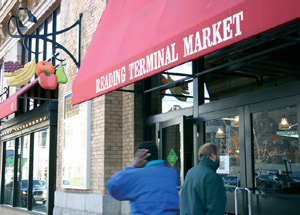Reading for Symbolism: An Ancient Tradition
The "Cosmopolitan Canopy" offers respite from racial, ethnic and social tensions of the city, says sociologist Elijah Anderson.

Tucked between Philadelphia's Chinatown and Kensington neighborhoods, in the shell of a former train shed, lies Reading Terminal Market. In the 1990s, during city's renaissance, the space evolved into a charming bazaar of restaurants, tchotchke vendors and food kiosks. Nowadays, itĚs an ideal place to go for, say, a quick lunch or some organic Amish produce. Few people, however, go to Reading Terminal to conduct serious work. But when Elijah Anderson, the Charles and William L. Day Distinguished Professor of the Social Sciences, began visiting the terminal he saw a space ripe with sociological phenomenon just begging to be studied.
What struck Anderson about the terminal, like so many other Philadelphia public spaces, was how "racially, ethnically and socially diverse" it was. "In a city that we suppose is so riven with race problems," he says, "I was surprised to find so much comity and goodwill."
That goodwill extended beyond simple politeness. One morning, while Anderson breakfasted at Down Home Diner, a stranger approached him to ask for the score of a 76ers game. On another occasion, "a white man with white-supremacist friends was able to have a frank discussion with me, a black man, in which he reveals his own feelings about race and diversity." Such encounters are possible, Anderson says, because public spaces like Reading Terminal form "cosmopolitan canopies," quasi-public spaces where people can let down their guard and, on occasion, approach strangers to talk, to joke or to share a story.
In an article published in "The Annals of the American Academy of Political and Social Science" (vol 595, no.1), Anderson fleshes out the concept of the cosmopolitan canopy, extending it to other Philadelphia institutions like Rittenhouse Square and jazz club Zanzibar Blue. Given the upscale nature of these haunts, it might seem like Anderson, author of ground-breaking inner-city ethnographies Code of the Street (1999) and A Place on the Corner (1981), has left behind the violent, blighted areas of his earlier research. But he says that, like W.E.B. DuBois, he doesn't just want to study the African American community inside neighborhood enclaves; he also wants to see how this community is impacted by other races and ethnicities outside of the inner-city.
Of course, the cosmopolitan canopy isn't exclusive to the Starbucks crowd; Anderson says that the liveliest melting pots he's seen are places like off-track betting parlors and hospital waiting rooms. He is currently writing an as-yet-untitled book on the basis of these and other observational case studies. The goal is to form a kind of "sociological theory of life in urban culture," he says. And while understanding the benefits of multiculturalism is a side thought, Anderson says that what really keeps him researching, what brings him back to Reading Terminal and the OTB parlors, is a burning "desire to understand the tension between ethnocentrism and cosmopolitanism." In other words: "figuring why and how black people intermingle in urban communities."

